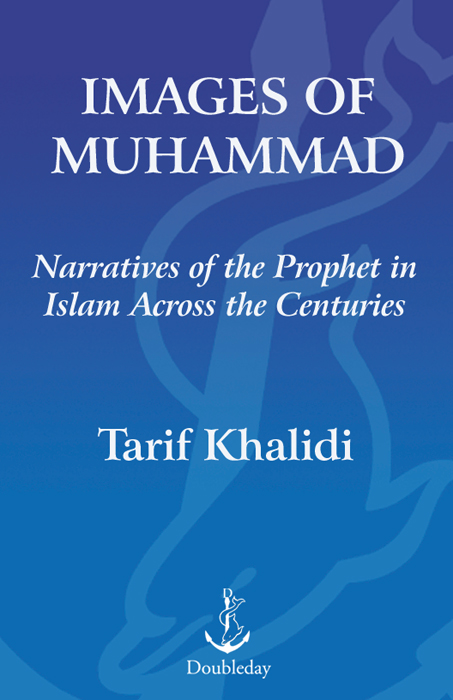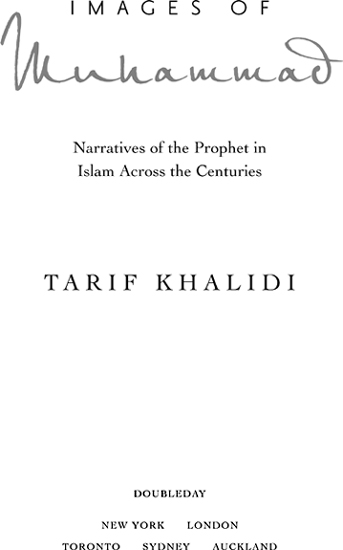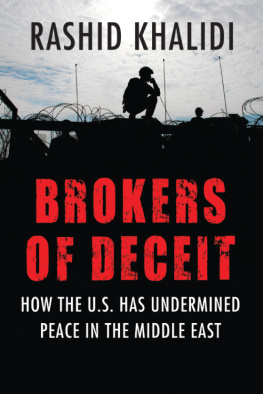Tarif Khalidi - Images of Muhammad
Here you can read online Tarif Khalidi - Images of Muhammad full text of the book (entire story) in english for free. Download pdf and epub, get meaning, cover and reviews about this ebook. year: 2009, publisher: Crown Publishing Group, genre: Religion. Description of the work, (preface) as well as reviews are available. Best literature library LitArk.com created for fans of good reading and offers a wide selection of genres:
Romance novel
Science fiction
Adventure
Detective
Science
History
Home and family
Prose
Art
Politics
Computer
Non-fiction
Religion
Business
Children
Humor
Choose a favorite category and find really read worthwhile books. Enjoy immersion in the world of imagination, feel the emotions of the characters or learn something new for yourself, make an fascinating discovery.

- Book:Images of Muhammad
- Author:
- Publisher:Crown Publishing Group
- Genre:
- Year:2009
- Rating:5 / 5
- Favourites:Add to favourites
- Your mark:
- 100
- 1
- 2
- 3
- 4
- 5
Images of Muhammad: summary, description and annotation
We offer to read an annotation, description, summary or preface (depends on what the author of the book "Images of Muhammad" wrote himself). If you haven't found the necessary information about the book — write in the comments, we will try to find it.
Images of Muhammad — read online for free the complete book (whole text) full work
Below is the text of the book, divided by pages. System saving the place of the last page read, allows you to conveniently read the book "Images of Muhammad" online for free, without having to search again every time where you left off. Put a bookmark, and you can go to the page where you finished reading at any time.
Font size:
Interval:
Bookmark:



| I NTRODUCTION Reflections on Muhammad and Biography | |
| I | T HE T URNING P OINT Muhammad in the Quran |
| II | T HE L EGISLATOR Muhammad in Hadith |
| III | T HE M ASTER N ARRATIVE Muhammad in the Sira |
| IV | T HE T EACHER OF M ANNERS Muhammad in Adab |
| V | T HE L IGHT OF THE W ORLD Muhammad in Shiite Biographies |
| VI | T HE M ODEL M YSTIC Muhammad in Sufi Literature |
| VII | T HE P ROPHET C ANONIZED Muhammads Sira in a New Canonical Age |
| VIII | T HE U NIVERSAL M ODEL Muhammad in Later Medieval Biography |
| IX | T HE H ERO Muhammad in Modern Biography |
| X | T HE L IBERATOR Muhammad in Contemporary Sira |

This is a book that exacts a lengthy toll of apologies and disclaimers from its author, a litany of excuses longer than the norm. Its subject is the evolution of the images of Muhammad as portrayed by his community across the centuries. It may be that the introduction that follows will clarify what is meant by this, but what I thought worth attempting was a kind of map of a literary tradition, from its origins to the present. I also suggest that there is a certain symmetry to that tradition. Although numerous studies exist on disparate aspects of that biographical tradition, I know of no study that casts an eye on the landscape as a whole. There may therefore be some value in having a large map, even if somewhat wrinkled and inaccurate in projection.
The sources are truly vast. There is hardly any work in any branch of Islamic studies written by Muslims, ancient or modern, that does not refer to Muhammad and his sayings or actions. He is simply everywhere in the literature, prose or verse, of his community. So I decided to confine myself by and large to the genre called the Sira, that is to say the genre of formal biography of Muhammad. Alas, here too the bulk, especially in the premodern period, is immense, and several primary works of the Sira will go unmentioned. I hope I have not done great violence to the Sira in omitting them, though other students of the genre will surely put matters right. Again, the Sira written in Arabic during the premodern period occupies center stage in this work, although the seminal modern contributions of Indian Muslims and Iranians are highlighted as well.
In telling the story of the Sira, and of other portrayals of his life that are not strictly Sira, I have kept away from historicity, from issues that have to do with their value as a factual source of information on Muhammads life, although much history can of course be learned from historiography. Instead, I have concerned myself primarily with social ideality, by which I mean the manner in which a religious society gradually builds up images of ideal conduct for its central figure or figures. I like to think of ideality as a subset of the social imaginary, that which drives a religious society to construct and reconstruct the ideal lives of its early heroes.
A question I sometimes used to set my students in early Arabic/Islamic history and culture went as follows: Muslims generally object to being called Muhammadans. With what justification? I no longer remember exactly what I expected from my students as an adequate answer, but this may have included a discussion of the tension between the human Muhammad and the Muhammad of miracle. Was he simply a messenger of God or was he more? And if more, how much more? This book is partially concerned with the answers to this question provided by the Sira.
But the social ideality of Muhammad is underlain by the love of his community. In 2006 Muhammad was the subject of a series of cartoons in the Danish press. The furor caused by that incident, like almost all similar furors, managed to obscure the raw nerve that these cartoons had touched. I am referring to the fact that little was said throughout that controversy about the love of Muhammad among his community, although much was said about respect for religious beliefs versus the primacy of free speech. At the heart of that incident was the love of Muhammad, which, in the phrase of Muhammad Iqbal, runs like blood in the veins of his community. It was Muhammad as comforter, friend, intercessor, family member that these cartoons seemingly demeaned. A clich has gained currency in recent years to the effect that the equivalent of Christ in Islam is not Muhammad but the Quran. That is not entirely true. The images of Muhammad collected in this book, from the Sira and other literary sources, may help to show how close the Prophet has been to his community, how much he remains at the center of their affection, and how vividly he still stands among them.
This book was first suggested by Trace Murphy at Random House. For his patience and constant encouragement, my heartfelt thanks. My thanks also to Darya Porat for her able shepherding of this work and to Maggie Carr for her perceptive and elegant copy-editing.
Two colleagues at the American University of Beirut read parts of this work and made numerous suggestions, almost all of which I immediately incorporated, with gratitude for their concern and critical acumen: Maher Jarrar and Muhammad Ali Khalidi. I exonerate them from any responsibility for what remains.
It was Magda who isolated me from my surroundings while I wrote, sent me back again and again to my labors, and firmly and lovingly insisted that I finish what I started. This makes her the maraine of all that follows.
T ARIF K HALIDI
Center for Arab and Middle Eastern Studies
American University of Beirut
March 10, 2009

Introduction
The name Muhammad means worthy of all praise. For fifteen centuries or so this name has reverberated around the world so that today one in every five human beings calls down daily praises and blessings upon him, feels secure in his faith and intercession, holds him up as a model of virtue and good manners, and goes on pilgimage to the holy sites he designated, treading the same ground he once trod. And what of the rest of humanity? One might assume a wide range of attitudes, all the way from curiosity to admiration to dread. This book is not a straight or objective biography of Muhammadthere are more than enough of these. It is instead a book about his Islamic images. To be more precise, it is a biographical account that attempts to explore the manner in which his life has been constructed and reconstructed, designed and redesigned, over the last millennium and a half. How has his community narrated his biography? And why is Muhammad still such a commanding and fascinating figure in the twenty-first century?
Font size:
Interval:
Bookmark:
Similar books «Images of Muhammad»
Look at similar books to Images of Muhammad. We have selected literature similar in name and meaning in the hope of providing readers with more options to find new, interesting, not yet read works.
Discussion, reviews of the book Images of Muhammad and just readers' own opinions. Leave your comments, write what you think about the work, its meaning or the main characters. Specify what exactly you liked and what you didn't like, and why you think so.






